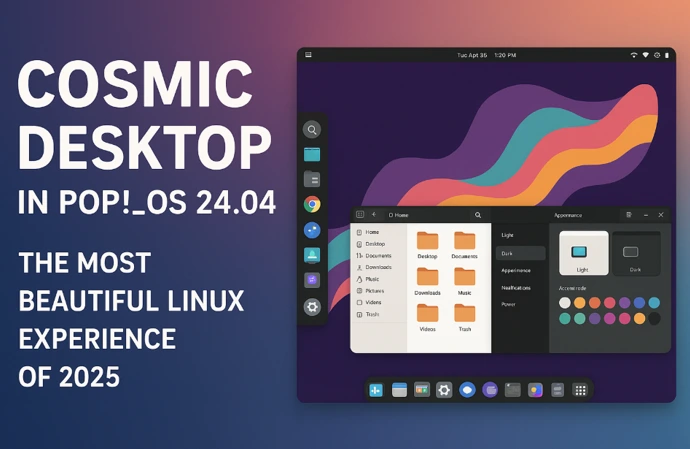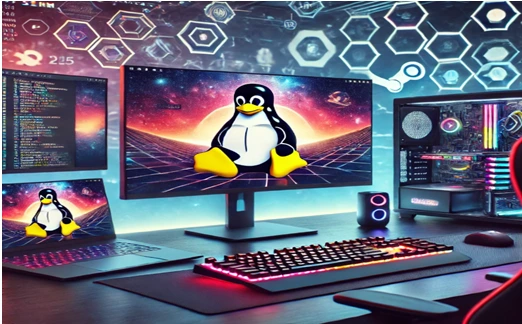
Best Linux Desktop Environment for Gaming in 2025
Gaming on Linux has never been more exciting or accessible. Over the years, Linux has transformed from a niche platform into a serious contender for gamers worldwide, thanks to advancements in hardware support, the Steam Deck revolution, and tools like Proton and Wine. But the key to unlocking the best gaming experience on Linux isn’t just about the right hardware or software—it’s also about choosing the perfect desktop environment (DE). Your DE can make or break your gaming setup, affecting everything from performance and resource usage to ease of navigation and aesthetics.
Whether you’re a seasoned Linux user or a newcomer ready to explore the world of open-source gaming, this guide will walk you through the best Linux desktop environments for gaming in 2025. Let’s dive in and find the perfect DE to level up your gaming experience.
Factors to Consider When Choosing a Desktop Environment for Gaming
1. Performance: A lightweight DE ensures minimal resource usage, leaving more system power for gaming.
2. Compatibility: Ensures smooth integration with gaming platforms like Steam, Lutris, or Heroic Launcher.
3. Customization: Easy customization allows gamers to tweak their environment for better usability.
4. Ease of Use: A user-friendly interface ensures that setup and management are hassle-free.
5. Aesthetics: Gaming setups often prioritize visual appeal, and DEs with modern designs are preferred.
6. Wayland/Support for Modern Graphics: Wayland, as the next-generation display server, can offer better gaming performance for certain setups compared to X11.
Best Linux Desktop Environment for Gaming in 2025
1. KDE Plasma
In the ever-evolving landscape of PC gaming, the desktop environment you choose can significantly impact your experience. KDE Plasma, renowned for its lightweight and highly customizable interface, has become a top choice for gamers in 2025. Here’s why KDE Plasma stands out as the ideal desktop environment for gaming enthusiasts this year.
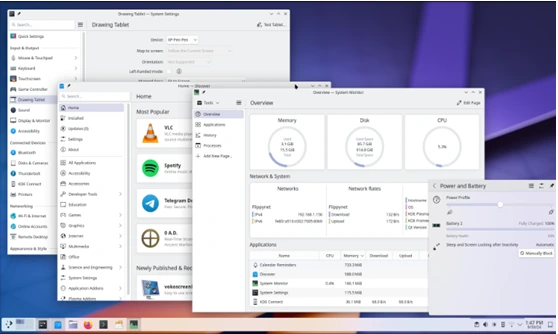
1. Performance Optimization
Gaming demands high performance, and KDE Plasma delivers with its efficient resource usage. In 2025, KDE Plasma continues to lead with optimized memory and CPU consumption, ensuring that system resources are primarily allocated to gaming rather than the desktop environment. This efficiency translates to smoother gameplay and reduced system bottlenecks.
2. Customization and Aesthetics
Gamers love to personalize their setups, and KDE Plasma excels in customization. From dynamic wallpapers and widget-rich desktops to tailored window behaviors, KDE Plasma allows gamers to create an immersive environment that complements their gaming rigs. New themes and icon packs released in 2025 offer even more ways to match your desktop aesthetics with your favorite games.
3. Wayland Advancements
Wayland support in KDE Plasma has seen remarkable improvements in 2025, providing gamers with better performance, lower latency, and more robust support for high-refresh-rate monitors. This ensures tear-free graphics and responsive controls, crucial for competitive gaming.
4. Gaming Mode Integration
KDE Plasma now includes a native “Gaming Mode,” which automatically optimizes system settings when launching games. This feature adjusts CPU priorities, disables unnecessary background services, and manages GPU performance to provide an uninterrupted gaming experience.
5. Compatibility with Game Stores and Launchers
Thanks to KDE Plasma’s compatibility with major game launchers like Steam, Epic Games Store (via Heroic Games Launcher), and Lutris, gamers can seamlessly access their game libraries. Enhanced Proton and Wine support in 2025 further ensure that even Windows-exclusive titles run smoothly on Linux.
6. Improved Hardware Support
KDE Plasma in 2025 boasts better hardware integration, including out-of-the-box support for the latest GPUs, gaming peripherals, and ultra-wide or high-refresh-rate monitors. This allows gamers to fully utilize their hardware without extensive configuration.
7. Enhanced Gaming Tools and Widgets
New widgets and tools have been introduced to KDE Plasma in 2025, including real-time system monitoring widgets, FPS counters, and performance graphs. These additions give gamers instant feedback on their system performance during gameplay.
KDE Plasma has cemented its place as a premier desktop environment for gamers in 2025. Its blend of performance optimization, advanced customization, and seamless integration with gaming tools makes it an excellent choice for both casual and competitive gamers. Whether you’re chasing high frame rates or crafting the perfect gaming aesthetic, KDE Plasma delivers a top-tier experience for Linux gaming.
2. GNOME
As gaming on Linux continues to surge in popularity, desktop environments like GNOME have evolved to meet the demands of gamers in 2025. With seamless integration, performance optimizations, and extensive customization, GNOME has positioned itself as a robust choice for gaming enthusiasts.
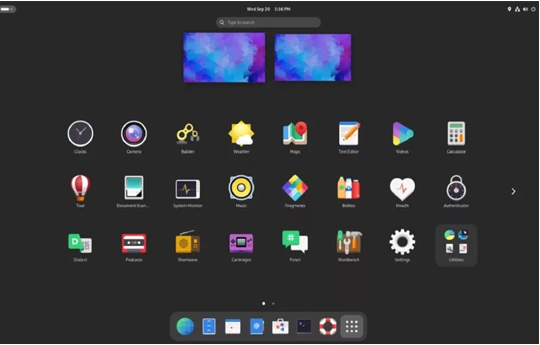
Why GNOME for Gaming?
1. Performance Optimization
GNOME has traditionally been criticized for being resource-intensive. However, the 2025 iterations have introduced significant performance optimizations. Reduced memory usage, faster load times, and smoother graphics rendering now ensure games run efficiently without compromising desktop performance.
2. Wayland Enhancements
The Wayland display server protocol has matured, offering lower latency and better performance compared to X11. GNOME’s tight integration with Wayland in 2025 ensures smoother gaming experiences, particularly for high-refresh-rate monitors and HDR support.
3. Gaming Mode Integration
Inspired by tools like GameMode by Feral Interactive, GNOME now includes a native Gaming Mode. This feature dynamically optimizes system resources for gaming, prioritizing CPU and GPU usage, disabling unnecessary background processes, and adjusting display settings for peak performance.
4. Steam and Lutris Integration
GNOME’s Software Center now supports direct installation and management of Steam, Lutris, and Heroic Games Launcher. This seamless integration simplifies game management and makes setting up Proton or Wine configurations more intuitive for users.
5. Controller and Peripheral Support
In 2025, GNOME boasts improved support for gaming peripherals. From game controllers to VR devices, plug-and-play functionality and customizable settings within the GNOME Control Center make hardware compatibility hassle-free.
6. Enhanced Customization and Extensions
Gamers love to tweak their systems, and GNOME delivers with a rich ecosystem of extensions. Custom HUD overlays, FPS counters, and game-specific UI themes allow for a personalized gaming environment.
Best GNOME Extensions for Gamers
- CPU Power Manager: Manage CPU frequencies to optimize game performance.
- GPU Profile Selector: Quickly switch between GPU performance modes.
- GameTracker: A desktop widget to track game stats, friends, and server statuses.
- Framerate Display: On-screen FPS counter for performance monitoring.
System Requirements for Optimal Performance
While GNOME has been optimized, gamers should consider the following specs for the best experience:
- CPU: Quad-core processor or better
- GPU: Dedicated GPU with Vulkan support (e.g., NVIDIA RTX 30/40 series, AMD RX 6000/7000 series)
- RAM: 16GB minimum
- Storage: SSD for faster game load times
- Display: 144Hz monitor for smoother gameplay
GNOME’s advancements in 2025 have made it a competitive and user-friendly desktop environment for gamers. With performance enhancements, better hardware support, and seamless integration with popular gaming platforms, GNOME is no longer just a productivity powerhouse—it’s now a gamer’s delight. Whether you’re into AAA titles or indie gems, GNOME offers a solid, customizable, and efficient gaming experience on Linux.
Make the switch and level up your Linux gaming with GNOME in 2025!
3. XFCE
Gaming on Linux has come a long way, and as we step into 2025, the landscape continues to evolve with more players seeking optimal performance without sacrificing system resources. One desktop environment (DE) that consistently stands out for its lightweight design and efficiency is XFCE. Let’s explore why XFCE remains a top choice for gamers in 2025.
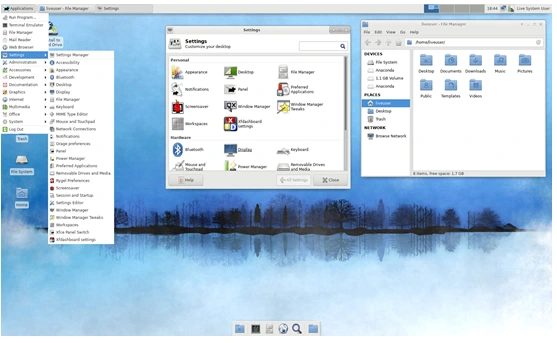
Why XFCE for Gaming?
1. Lightweight and Resource-Efficient
XFCE is renowned for its low system resource consumption. In gaming, where every bit of CPU and RAM counts, XFCE ensures more resources are dedicated to running games rather than the desktop environment. This translates to smoother gameplay and reduced input lag.
2. Customizability Without Bloat
Gamers can tailor XFCE to suit their aesthetics and functional needs without compromising performance. From lightweight panels to customizable window managers, XFCE offers flexibility that can be optimized for gaming setups, including game launchers and overlays.
3. Stability and Reliability
XFCE has a long-standing reputation for stability. This reliability is crucial for gaming, where crashes or glitches can disrupt gameplay. With XFCE, users benefit from a mature and well-supported environment that ensures consistent performance.
4. Compatibility with Gaming Tools
In 2025, tools like Proton, Lutris, and Steam Play have become integral to Linux gaming. XFCE seamlessly integrates with these tools, providing a hassle-free experience when setting up and running games. Moreover, it works well with GPU drivers and game performance optimizers.
5. Improved Wayland Support
While XFCE traditionally focused on X11, the gradual adoption of Wayland in 2025 has enhanced gaming performance and security. XFCE’s evolving support for Wayland ensures compatibility with the latest game engines and graphical improvements.
Optimizing XFCE for Gaming
1. Disabling Unnecessary Services
To squeeze out extra performance, disable services and background processes that are not essential. XFCE makes this easy through its session and startup settings.
2. Compositor Tweaks
Adjusting or disabling the XFCE compositor can prevent screen tearing and improve frame rates. Tools like picom offer lightweight compositing if needed.
3. Game Mode Integration
Tools like Feral Interactive’s GameMode can prioritize gaming processes. XFCE can integrate these optimizations seamlessly, ensuring peak performance during gaming sessions.
4. Minimalist Themes and Icons
Using lightweight themes and icon packs reduces GPU overhead. XFCE’s vast theme support allows for a sleek yet resource-efficient desktop.
Comparision table XFCE vs. Other Desktop Environments
| Feature | XFCE | GNOME | KDE Plasma |
|---|---|---|---|
| Resource Usage | Low | High | Moderate |
| Customizability | High | Moderate | High |
| Gaming Performance | Excellent | Moderate | Excellent |
| Wayland Support | Improving | Mature | Mature |
| Stability | Very High | Moderate | High |
As gaming on Linux continues to thrive in 2025, choosing the right desktop environment is crucial for maximizing performance. XFCE stands out for its lightweight footprint, customizability, and reliability—making it an excellent choice for gamers who want every ounce of power directed toward their games. Whether you’re diving into AAA titles via Proton or enjoying indie gems, XFCE ensures a seamless and optimized gaming experience.
Give XFCE a try and experience how a lightweight desktop environment can transform your Linux gaming setup!
4. Budgie
As the gaming landscape continues to evolve in 2025, the demand for a desktop environment that blends performance, aesthetics, and customization has never been higher. Budgie Desktop Environment, known for its sleek design and user-friendly interface, has emerged as a compelling choice for gamers seeking both functionality and style. Let’s explore why Budgie stands out for gaming in 2025.
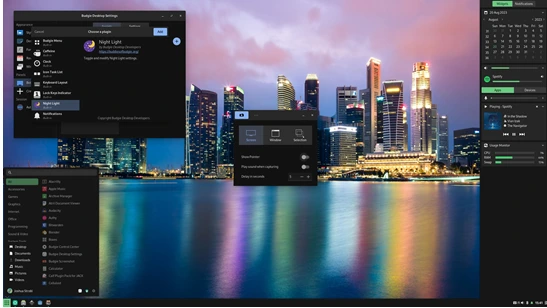
1. Performance Optimization
Budgie’s lightweight architecture ensures that system resources are used efficiently, allowing games to run smoothly without unnecessary background bloat. Recent updates in 2025 have further refined memory and CPU management, reducing latency and improving load times for modern, resource-intensive games.
Key Features:
- Minimal Background Processes: Budgie minimizes non-essential services, ensuring maximum resources for gaming.
- Wayland Support: Improved Wayland support provides better frame rates and reduced input lag, a significant boost for competitive gamers.
- Dynamic Resource Management: Real-time resource allocation ensures optimal performance during high-load gaming sessions.
2. Customizable Gaming Interface
Customization is critical for gamers who want to create immersive setups. Budgie’s Raven Sidebar and widget system allow players to tailor their desktop to match their gaming aesthetic and workflow.
Customization Options:
- Game Launchers Integration: Seamlessly integrates with Steam, Lutris, and Heroic Games Launcher.
- Gaming Mode Widgets: Quick-access widgets for performance monitoring, system stats, and GPU temperature.
- Dynamic Themes: Automatic theme adjustments to match in-game environments or time of day.
3. Compatibility and Software Support
Gaming on Linux has seen substantial growth, and Budgie keeps up with these developments by offering excellent compatibility with popular gaming platforms and tools.
Supported Platforms:
- Steam Play & Proton: Enhanced compatibility with Windows games via Proton.
- Native Game Support: Smooth performance with native Linux games.
- Cloud Gaming: Optimized support for services like NVIDIA GeForce NOW and Xbox Cloud Gaming.
4. Enhanced Gaming Tools and Utilities
Budgie in 2025 comes equipped with gaming-centric utilities to improve the overall experience.
Notable Tools:
- FPS and Latency Monitors: Built-in tools for real-time performance tracking.
- GPU Overclocking Widgets: Direct control over GPU performance without leaving the desktop.
- Audio Profiles: Custom sound profiles for different gaming genres.
5. Stability and Security
Gamers need a stable and secure environment. Budgie delivers with regular updates, robust security measures, and a strong community supporting continual improvement.
Security Highlights:
- Sandboxed Gaming Environments: Protects against potential threats from third-party game mods.
- Rolling Release Updates: Ensures up-to-date drivers and system components for the latest games.
In 2025, the Budgie Desktop Environment has matured into an exceptional platform for gamers. Its combination of performance optimization, customization, and robust gaming support makes it a top choice for Linux gaming enthusiasts. Whether you’re a casual player or a competitive gamer, Budgie provides a seamless and visually appealing experience that enhances every gaming session.
Ready to level up your gaming experience? Give Budgie a try and immerse yourself in a desktop environment designed with gamers in mind.
5. Cinnamon
As PC gaming continues to evolve in 2025, choosing the right desktop environment (DE) has become increasingly important for gamers who value both performance and aesthetics. Cinnamon, a desktop environment originally developed for Linux Mint, has gained popularity among gamers due to its balance of modern design, lightweight performance, and extensive customization options. In this post, we will explore why Cinnamon is an excellent choice for gamers in 2025 and how to optimize it for the best gaming experience.
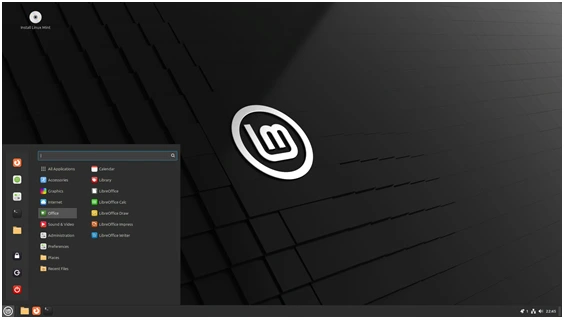
Why Cinnamon for Gaming?
- Lightweight and Efficient: Cinnamon offers a sleek interface without being resource-hungry. This means more system resources are available for gaming, reducing lag and improving overall performance.
- Modern Aesthetics: With its clean and modern design, Cinnamon appeals to gamers who appreciate a visually pleasing desktop environment that doesn’t compromise speed.
- Customizability: Cinnamon allows extensive customization through themes, applets, and desklets, enabling gamers to tailor their desktop to suit their gaming setup and preferences.
- Stability and Support: Built on solid Linux foundations, Cinnamon provides a stable and reliable environment, which is crucial for uninterrupted gaming sessions.
- Compatibility with Game Launchers: Cinnamon seamlessly supports popular game launchers like Steam, Lutris, and Heroic Games Launcher, making it easy to access and manage game libraries.
Optimizing Cinnamon for Gaming
To maximize gaming performance on Cinnamon in 2025, consider these optimization tips:
- Enable Performance Mode: Many Linux distributions now offer a performance mode to prioritize system resources for demanding applications. Ensure this mode is enabled during gaming sessions.
- Install Proprietary GPU Drivers: For the best graphics performance, use proprietary drivers for NVIDIA or AMD GPUs, which often deliver better frame rates and stability compared to open-source alternatives.
- Disable Unnecessary Startup Applications: Streamline system performance by disabling unnecessary background applications and services that consume resources.
- Use a Lightweight Window Manager for Intensive Games: For resource-intensive games, consider temporarily switching to a more lightweight window manager or disabling desktop effects in Cinnamon.
- Optimize Game Settings with Tools: Utilize tools like GameMode and MangoHud to optimize game performance and monitor system metrics in real-time.
In 2025, the Cinnamon desktop environment continues to be an excellent choice for gamers who want a blend of performance, customization, and visual appeal. By implementing optimization strategies and selecting the right Linux distribution, gamers can enjoy a seamless and immersive gaming experience. Whether you’re a casual player or a hardcore enthusiast, Cinnamon provides the tools and flexibility needed to elevate your gaming setup.
Honorable Mentions
- LXQt: Ultra-lightweight but lacks the polish and modern features needed for most gaming setups.
- Deepin: Gorgeous aesthetics but heavier on system resources, making it less ideal for high-performance gaming.
- Pantheon: Beautiful but primarily tailored for productivity rather than gaming.
Recommendations Based on Hardware
High-End Systems:
- KDE Plasma (for customization and modern features)
- GNOME (for polished and streamlined experiences)
Mid-Range Systems:
- XFCE (for performance and stability)
- Budgie (for lightweight yet stylish gaming)
Low-End Systems:
- LXQt or XFCE (to maximize available resources for gaming)
Conclusion
Choosing the right desktop environment for gaming in 2025 depends on your hardware, personal preferences, and gaming needs. KDE Plasma stands out as the best all-around choice due to its balance of performance, customization, and modern features. However, GNOME and XFCE offer compelling alternatives for those prioritizing simplicity or resource efficiency. Regardless of your choice, Linux continues to prove itself as a robust platform for gaming, offering flexibility and control unmatched by other operating systems.
Which desktop environment do you use for gaming? Let us know in the comments below!
Disclaimer
The information provided in this blog is based on research and personal experience as of 2025. Performance and compatibility may vary depending on your specific hardware and software configuration. Always test and evaluate the desktop environment that suits your needs best. The recommendations made here are subjective and should not be considered as definitive. We encourage readers to explore and experiment to discover what works best for their unique setups.
Also Read
Which Linux Distro is Best for Gaming in 2025?

